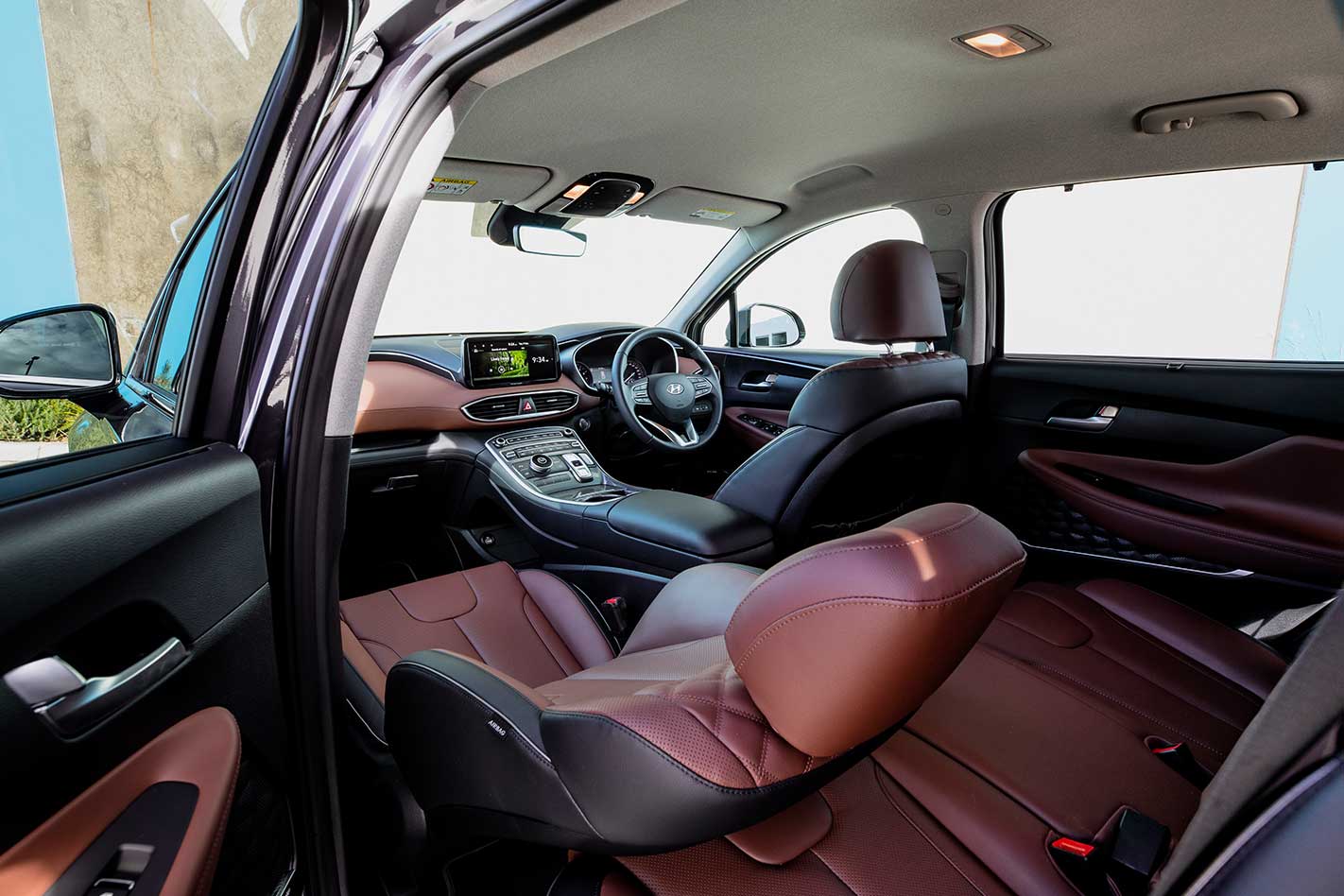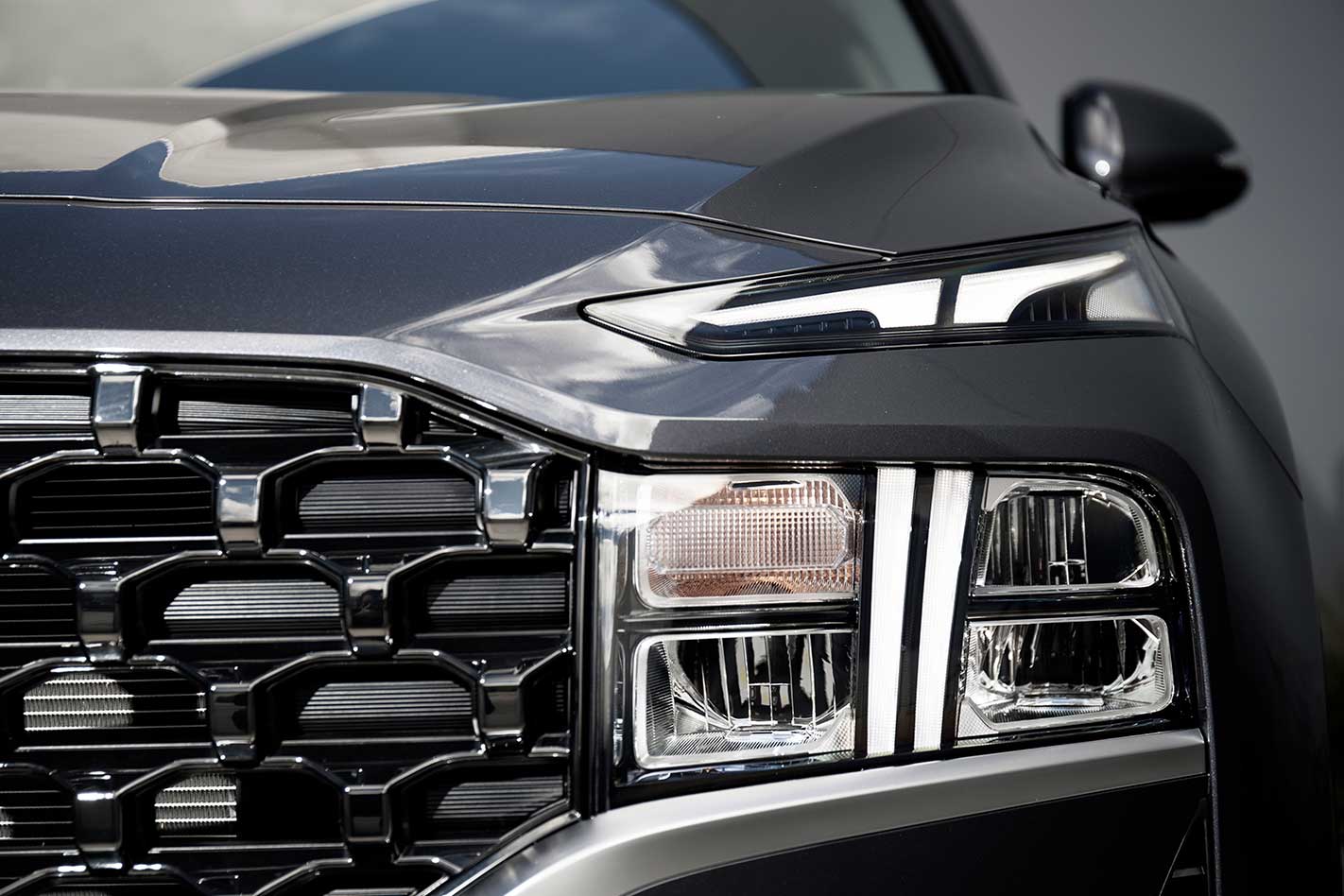
Assumptions are fraught with danger. When presented with a one-or-the-other choice, often the option you think is a no-brainer could, in fact, garner the complete opposite response from someone else.
Hence when the updated fourth generation Hyundai Santa Fe launched at the tail end of 2020 sans V6 petrol power, it didn’t present as an issue for some. That’s because, in terms of frugality and driveability at least, the 2.2-litre four-cylinder turbo diesel is the better choice.
However, after conversations with punters looking to buy in this segment, momentum started to build a case against the torque-laden oiler and for the 3.5-litre V6.

And that’s not conducive to a long stint in the country, something the DPF needs regularly to cleanse. Monetary concerns also come into play, with the R Series diesel costing more to initially purchase and service.
The Santa Fe range comprises four grades including a base model ($44,700), Active ($48,300), Elite tested here ($54,300) and Highlander ($61,000) for the front-wheel drive petrol V6.

The V6 will also accept cheaper 91RON fuel and, at $399 per service for the first five years (12month/15,000km intervals), its $60 less expensive each time you visit your local Hyundai dealer. The brand’s five-year, unlimited-kilometre warranty also applies.
A rather nondescript design has been revamped with striking details, big wheels and a cascading grille flanked by stacked headlights. At the back, an in vogue tail-light bar connects LED brake lights.

Sounds like music to the ears of family buyers, then, with ample room for heads, shoulders, knees and toes. The sliding middle row gains 39mm of legroom (the backrest can also recline), while both the middle and third rows fold for a flat load area.

A commodious 1649 litres is available with all but the driver and front passenger’s seat stowed. There’s a provision for the cargo cover beneath the boot floor, while the full-size alloy spare wheel is located under the chassis.

Fit and finish also feels solid and the Cognac Brown leather adds visual appeal to our test car. General ergonomics are well thought out and NVH levels are reasonably low in the insulated cabin.
However, if you don’t want to wake the kiddies in the back, Quiet mode cancels the rear speakers and limits the speaker volume up front to allow passengers some sleep.

Given how infrequently the selector will be used, especially without much off-road capability, it strikes out as an odd decision.
There are also four blanked-out buttons which are used for the seat heating/cooling controls, but they’re only fitted to the Highlander – as is the cool ambient lighting with 64 different colours to choose from.

It’s an intuitive system with attractive graphics, while the screen quick to react to inputs. Only the Highlander gets the 12.3-inch LCD instrument cluster, which displays the Blind-Spot View Monitor technology and utilises virtual dials in an array of configurations.
The Elite also scores DAB+ digital radio as well as a Hardon Kardon audio system, which delivers high-quality sound.

Rather annoyingly, while the smaller 8.0-inch screen offers wireless Apple CarPlay and Android Auto (like the updated i30 and Kona), the larger display fitted to the two range-topping variants does not – it’s wired. Wireless Qi smartphone charging is standard on all Santa Fes.
In terms of safety, the revised Santa Fe achieves a five-star ANCAP rating – which is carried over from the fourth generation.

Other safety features include active cruise control with Stop&Go function, Lane Following Assist and rear Cross-Traffic Collision Avoidance. Full curtain airbags stretch across all three rows.
While the pragmatic qualities of the Santa Fe feature no matter what engine you choose, it’s the updated Lambda II petrol V6 in the spotlight here.

Its 200kW and 331Nm is sent to the front wheels alone via an in-house eight-speed torque-converter automatic (the diesel uses a new eight-speed dual-clutch gearbox).
On paper those figures would suggest spirited performance. However, both peak power and torque are developed high in the rev range, 6400 and 5000rpm respectively, meaning you need a strong prod of the accelerator to gain meaningful progress.

To this end, the diesel makes more sense for CBD driving in both raw figures and performance. While it might produce just 148kW, its 440Nm of torque is delivered in a meaty 1750-2750rpm mid-range and hauls the circa 1800kg mass effortlessly.
Dynamically the Santa Fe V6 Elite acquits itself well with confidence-inspiring handling, thanks largely to the impressive body control (for an SUV) as a result of the monocoque construction.

What doesn’t work is the front-wheel-drive layout as the V6 all too easily produces wheelspin off the line and falls foul to torque steer when throttle and lock is applied concurrently.

The new N3 platform, which is shared with the latest Kia Sorento, houses MacPherson struts up front and multi-link suspension at the back.
Paired with passive dampers, the setup delivers commendable control on rebound. The Elite V6 doesn’t bobble after mid-corner bumps and generally remains composed without much head toss despite the tall frame.

Both powertrains are endowed with a 2500kg towing capacity and a maximum of 200kg towball weight.
Ground clearance sits at 176mm, but without all-wheel drive or dedicated off-road modes, a smooth dirt track to camping grounds is about all the Santa Fe V6 Elite will be tasked with – especially given the design of the big wheels, which are wrapped in road-focused 255/45 rubber.

However, there is a third way. A hybrid powertrain is imminent (second half of this year) for the Santa Fe, with a 1.6-litre four-cylinder turbo petrol engine pairing with an electric motor and battery pack – the former powering the front axle and that latter the rear to effectively create all-wheel drive. Combined power and torque is expected to be around 169kW/350Nm.

The Elite V6 occupies a happy middle-to-high ground within the lineup where you receive all the design/spec elements you want, paired with the cheaper bent six. It’s safe to assume that this seven-seat SUV should be on all shopping lists.
8/10
Pros: Premium look/feel; seven-seat functionality; standard equipment
Cons: Traction issues; V6 thirst; no wireless smartphone mirroring in Elite
Specifications
Body: 5-door, 7-seat SUV Drive: front-wheel Engine: 3470cc V6, DOHC, 24v Power: 200kW @ 6400rpm Torque: 331Nm @ 5000rpm Transmission: 8-speed automatic Weight: 1735kg Economy: 10.5L/100km (claimed) Price: $54,300 On sale: Now




